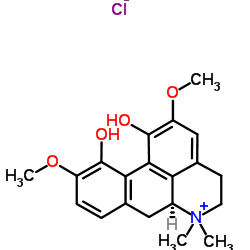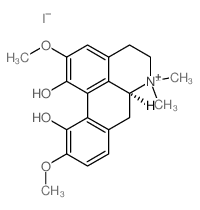(+)-Magnoflorine chloride
Modify Date: 2025-08-25 14:34:41

(+)-Magnoflorine chloride structure
|
Common Name | (+)-Magnoflorine chloride | ||
|---|---|---|---|---|
| CAS Number | 6681-18-1 | Molecular Weight | 377.862 | |
| Density | N/A | Boiling Point | N/A | |
| Molecular Formula | C20H24ClNO4 | Melting Point | N/A | |
| MSDS | N/A | Flash Point | N/A | |
Use of (+)-Magnoflorine chlorideMagnoflorine chloride (Magnoflorine chloride), an aporphine alkaloid found in Acoruscalamus, reduces the formation of C. albicans biofilm[1]. Magnoflorine chloride has anti-fungal, anti-antidiabetic and anti-oxidative activity[2]. |
| Name | Magnoflorine chloride |
|---|---|
| Synonym | More Synonyms |
| Description | Magnoflorine chloride (Magnoflorine chloride), an aporphine alkaloid found in Acoruscalamus, reduces the formation of C. albicans biofilm[1]. Magnoflorine chloride has anti-fungal, anti-antidiabetic and anti-oxidative activity[2]. |
|---|---|
| Related Catalog | |
| References |
| Molecular Formula | C20H24ClNO4 |
|---|---|
| Molecular Weight | 377.862 |
| Exact Mass | 377.139374 |
| PSA | 58.92000 |
| InChIKey | STVJLBTYWBXDBP-ZOWNYOTGSA-N |
| SMILES | COc1ccc2c(c1O)-c1c(O)c(OC)cc3c1C(C2)[N+](C)(C)CC3.[Cl-] |
| Storage condition | 2-8°C |
CHEMICAL IDENTIFICATION
HEALTH HAZARD DATAACUTE TOXICITY DATA
|
| Precursor 0 | |
|---|---|
| DownStream 1 | |
| Corytuberine methochloride |
| Magnoflorine chloride |
| 1,11-dihydroxy-10-methoxynaphthacene-5,12-dione |
| (6aS)-1,11-Dihydroxy-2,10-dimethoxy-6,6-dimethyl-5,6,6a,7-tetrahydro-4H-dibenzo[de,g]quinolinium chloride |
| 4H-Dibenzo[de,g]quinolinium, 5,6,6a,7-tetrahydro-1,11-dihydroxy-2,10-dimethoxy-6,6-dimethyl-, chloride, (6aS)- (1:1) |
| 5,12-Naphthacenedione,1,11-dihydroxy-10-methoxy |
| Thalictrine chloride |
 CAS#:4277-43-4
CAS#:4277-43-4
